
Dalgarven Mill
Encyclopedia
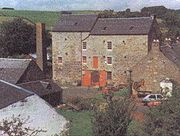
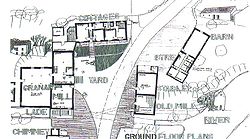
Kilwinning
Kilwinning is a historic town in North Ayrshire, Scotland. It is known as The Crossroads of Ayrshire. The 2001 Census recorded it as having a population of 15,908.-History:...
, in the Garnock Valley, North Ayrshire
North Ayrshire
North Ayrshire is one of 32 council areas in Scotland with a population of roughly 136,000 people. It is located in the south-west region of Scotland, and borders the areas of Inverclyde to the north, Renfrewshire to the north-east and East Ayrshire and South Ayrshire to the East and South...
, Scotland and it is home to the Museum of Ayrshire Country Life and Costume. The watermill
Watermill
A watermill is a structure that uses a water wheel or turbine to drive a mechanical process such as flour, lumber or textile production, or metal shaping .- History :...
has been completely restored over a number of years and is run by the independent Dalgarven Mill Trust.
The village of Dalgarven was largely destroyed by the construction of the main A737 road, but the mill buildings survive and are open as a tourist attraction and educational resource, interpreting local history in addition to its role as a museum of Ayrshire country life. Very few mills remain in Ayrshire and this is an example which has been preserved due to the foresight of the family of the last miller who saw a modern role for an ancient industrial site and traditional social meeting-place. Some of the outbuildings have been converted for use as an antique shop, others are still occupied as dwellings and some are in the process of being converted to uses which will enhance the quality of the experience of visitors to the mill complex.
The Ferguson family, descendents of the last miller, are still involved with the running of the museum, working with a board of trustees who are all volunteers. The mill is not part of the National Trust
National Trust for Scotland
The National Trust for Scotland for Places of Historic Interest or Natural Beauty, commonly known as the National Trust for Scotland describes itself as the conservation charity that protects and promotes Scotland's natural and cultural heritage for present and future generations to...
or the Museum of Scotland; it is however an accredited four star Ayrshire visitor attraction.
History of the Dalgarven mills
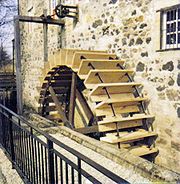
Kilwinning Abbey
Kilwinning Abbey is a ruined abbey located in the centre of the town of Kilwinning, North Ayrshire.-The establishment of the Abbey:The ancient name of the town is 'Segdoune' or 'Saigtown', probably derived from 'Sanctoun', meaning the 'town of the saint'. Saint Winnings festival was on 21 January...
. The first mill was a waulk or fulling mill producing woollen cloth. Retting
Retting
Retting is a process employing the action of micro-organisms and moisture on plants to dissolve or rot away much of the cellular tissues and pectins surrounding bast-fibre bundles, and so facilitating separation of the fibre from the stem...
was carried out here in ponds next to the river, this process being a stage in the manufacturing of vegetable fibres, especially the bast fibres. It involves submerging plant stems such as flax
Flax
Flax is a member of the genus Linum in the family Linaceae. It is native to the region extending from the eastern Mediterranean to India and was probably first domesticated in the Fertile Crescent...
, jute
Jute
Jute is a long, soft, shiny vegetable fibre that can be spun into coarse, strong threads. It is produced from plants in the genus Corchorus, which has been classified in the family Tiliaceae, or more recently in Malvaceae....
or hemp
Hemp
Hemp is mostly used as a name for low tetrahydrocannabinol strains of the plant Cannabis sativa, of fiber and/or oilseed varieties. In modern times, hemp has been used for industrial purposes including paper, textiles, biodegradable plastics, construction, health food and fuel with modest...
in water, and soaking them for a period of time to loosen the fibers from the other components of the stem. The fibres can then be used to produce linen and other products, such as paper for banknotes, rope, etc.
The present mill was erected in 1614 as a corn mill and rebuilt in 1880 after being damaged by fire. The River Garnock
River Garnock
The River Garnock, the smallest of Ayrshire's six principal rivers, has its source on the southerly side of the Hill of Stake in the heart of the Clyde Muirshiel Regional Park. About a mile and a half south of this starting point the untested stream tumbles over the Spout of Garnock, the highest...
's waters power a 6-metre diameter breast-shot wheel that drives the French burr millstones through cast iron gearing.
The traditional methods of producing flour can be followed during a tour of the mill. The wheel turns, when possible, following the almost total renewal of the mill machinery and a recent (2006-9) replacement of wooden components of the wheel, sluice, etc.
The mill race, leat or lade was critical to the efficient working of the mill and was a specialised craft; a leatwright is recorded on a grave in the Loudoun
Loudoun
Loudoun is an area of East Ayrshire, Scotland, east of Kilmarnock. The word Loudoun is a derivative of the Celtic Pagan God name Lugus.Loudoun is a parish and is named after the former village which stood north of Galston. The area is commonly referred to as the "Irvine Valley", for the River...
Kirk graveyard near Galston, East Ayrshire
Galston, East Ayrshire
Galston is a town in East Ayrshire, Scotland which has a population of 5000 . It is situated in wooded countryside 4 miles up-river from Kilmarnock and is one a group of the small towns located in the Irvine Valley between the towns of Hurlford and Newmilns. Galston is located in the Loudoun area...
.
The weir
Weir
A weir is a small overflow dam used to alter the flow characteristics of a river or stream. In most cases weirs take the form of a barrier across the river that causes water to pool behind the structure , but allows water to flow over the top...
on the River Garnock is made of boulders which are carefully placed and locked together creating a millpond that supplies a good head of water to the wheel through the lade. The weir was built on a natural dyke which runs across the Garnock at this point, its existence being carefully exploited by the monks of Kilwinning Abbey
Kilwinning Abbey
Kilwinning Abbey is a ruined abbey located in the centre of the town of Kilwinning, North Ayrshire.-The establishment of the Abbey:The ancient name of the town is 'Segdoune' or 'Saigtown', probably derived from 'Sanctoun', meaning the 'town of the saint'. Saint Winnings festival was on 21 January...
who chose the site for the mill. These dykes (bands of especially hard rock) are found at several points crossing the river and many were elsewhere were exploited as the bases for dams, such as also occurred at Cunninghamhead
Cunninghamhead
Cunninghamhead is a hamlet in North Ayrshire, Scotland. It was the centre of the lands of Cunninghamhead, Perceton and Annick Lodge in Cunninghame...
Mill on the River Annick
River Annick
The Annick Water is the largest tributary of the River Irvine. The river runs from Long Loch, just inside East Renfrewshire, in a generally south-western direction through North Ayrshire and East Ayrshire, to confluence with its parent river at Irvine, North Ayrshire on the west coast of Scotland...
.
A feature of many mills was the presence of trees or other structures shading the wheel from the intense summer sun. The reason for this was that when the wheel was not turning the wood components dried out and warped, putting a great deal of stress on the whole structure, putting it out of shape and creating breaks in the buckets, etc. At Dalgarven the wheel was originally enclosed by high walls which served the same purpose as trees.
The Dalgarven wheel is a low breastshot, where the water strikes the wheel at a quarter of its diameter or height of the wheel and it turns with an anti-clockwise rotation. On the outer edge of each bucket is a 'sacrificial board' which will break away if any object becomes wedged beneath it. This is very important, as the stresses and strains set up by the wheel suddenly stopping would cause considerable damage to the various cogs and to the drive to the grinding stones themselves, which have significant mass and momentum when employed in the process of grinding. The use of iron brackets to provide support to the wooden paddles on the wheel is an unusual feature. The massive wooden hirst supporting the grindstones can be viewed from inside of the mill.
In the 1940s, the miller at Dalgarven used the wheel to produce electricity which was stored in liquid acid batteries. At present (2006) the Mill Trustees are looking into the possibilities of using the wheel to produce electricity to help offset the mills contribution to global warming on the basis of 'Think Global, Act Local'.

One feature of the mill is the relatively small number of windows. This may be purely practical, however avoidance of paying too high a 'window tax
Window tax
The window tax was a significant social, cultural, and architectural force in England, France and Scotland during the 18th and 19th centuries. Some houses from the period can be seen to have bricked-up window-spaces , as a result of the tax.-Details:The tax was introduced in England and Wales under...
' may have been a consideration. Window tax was first levied in England in 1696 to offset the expenses of making up the gold and silver deficiency in the re-coinage of William III reign
Great Recoinage of 1696
The Great Recoinage of 1696 was an attempt by the British Government to replace the hammered silver that made up most of the coinage in circulation, much of it being clipped and badly worn. -History:English currency was in disarray in the late 17th century...
caused by clipping and filing of coins. It was set at two shillings for small tenements, six shillings for buildings with up to ten windows and ten shillings for those with twenty windows. Cottages were exempt. It was based on the number of windows in a house and large mansions often had many existing windows blocked up, such as a whole side of Loudoun Castle, in Ayrshire, Scotland. It was repealed in 1851 and replaced by a tax on inhabited houses.
Lying on the cobbles outside the original mill is a large oval sandstone object with metal attachments on its central axis. This was used to crush whin or gorse
Gorse
Gorse, furze, furse or whin is a genus of about 20 plant species of thorny evergreen shrubs in the subfamily Faboideae of the pea family Fabaceae, native to western Europe and northwest Africa, with the majority of species in Iberia.Gorse is closely related to the brooms, and like them, has green...
in a shallow trough, the stone being dragged up and down by a horse, making the spiny and tough branches of the plant suitable for use as animal feed. It was however only used if other sources of feed were lacking.
The mill's history is laid out in the Trust's publication - A Miller's Tale. The Life and Times of Dalgarven Mill, by Robert Ferguson, son of the last miller.
Heron, on a tour of Scotland in 1799, records that the miller at Dalgarven had constructed a wooden bridge in the Japanese style and interesting gardens with patterns of low box hedges.
The Sound of a waterwheel and associated milling machinery
The Miller's Tale
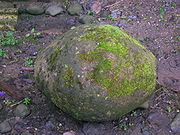
Miller
A miller usually refers to a person who operates a mill, a machine to grind a cereal crop to make flour. Milling is among the oldest of human occupations. "Miller", "Milne" and other variants are common surnames, as are their equivalents in other languages around the world...
was an important member of the rural community and honesty was an important and valued characteristic, for he had many opportunities to cheat the farmer; worst of all, he might knowingly accept blighted seeds which would result in ergotism
Ergotism
Ergotism is the effect of long-term ergot poisoning, traditionally due to the ingestion of the alkaloids produced by the Claviceps purpurea fungus which infects rye and other cereals, and more recently by the action of a number of ergoline-based drugs. It is also known as ergotoxicosis, ergot...
. When milled, the ergot
Ergot
Ergot or ergot fungi refers to a group of fungi of the genus Claviceps. The most prominent member of this group is Claviceps purpurea. This fungus grows on rye and related plants, and produces alkaloids that can cause ergotism in humans and other mammals who consume grains contaminated with its...
on the seeds is reduced to a red powder, obvious in lighter grasses but easy to miss in dark rye flour. In the Middle Ages gangrenous ergotism poisoning was known as "holy fire" or "St Anthony's fire
Anthony the Great
Anthony the Great or Antony the Great , , also known as Saint Anthony, Anthony the Abbot, Anthony of Egypt, Anthony of the Desert, Anthony the Anchorite, Abba Antonius , and Father of All Monks, was a Christian saint from Egypt, a prominent leader among the Desert Fathers...
". The blight, named from the cock's spur it forms on grasses, was identified and named by Denis Dodart who reported the relation between ergotized rye and bread poisoning. It has been suggested that many of the people whose accusations resulted in the 1692 Salem witch trials
Salem witch trials
The Salem witch trials were a series of hearings before county court trials to prosecute people accused of witchcraft in the counties of Essex, Suffolk, and Middlesex in colonial Massachusetts, between February 1692 and May 1693...
in Massachusetts
Massachusetts
The Commonwealth of Massachusetts is a state in the New England region of the northeastern United States of America. It is bordered by Rhode Island and Connecticut to the south, New York to the west, and Vermont and New Hampshire to the north; at its east lies the Atlantic Ocean. As of the 2010...
were genuinely suffering hallucinations and other symptoms of convulsive ergotism.
Notable epidemics of ergotism, at first seen as a punishment from God, occurred up into the 19th century. Fewer outbreaks have occurred since then, because in developed countries rye is carefully monitored. Whenever there is a combination of moist weather and cool temperatures which favour the growth of the fungus that causes the ergotism.
It was not easy being a miller, for instance some people held the belief that it was wrong to use water artificially; that to turn water from its course was to act against God's plan.
Ancient mills, it was believed, had been piously placed by their forefathers where they could be worked according to God's order, without artificially embanking the water or turning it from its natural course, which would be sinful.
In the Waverley novel Kenilworth
Kenilworth (novel)
Kenilworth. A Romance is a historical novel by Sir Walter Scott, first published on 8 January 1821.-Plot introduction:Kenilworth is apparently set in 1575, and centers on the secret marriage of Robert Dudley, 1st Earl of Leicester, and Amy Robsart, daughter of Sir Hugh Robsart...
, Sir Walter Scott has Anthony Foster described as avaricious with the phrase and grudged, as men say, every drop of water that went past his own mill.
The symbol of a miller, such as that seen on gravestones, was the rynd
Rynd
A millrind or simply rind is an iron support, usually four-armed or cross-shaped, for the turning stone in a pair of millstones. It is sometimes spelled millrynd or rynd....
, the iron part that supports the upper millstone.
One epitaph to a miller reads:
Millstones are 'dressed' (re-cut with grooves) as they wear down; an exacting task. Travelling mill stone dressers would often take on the work in place of the miller and they used a tool called a 'mill bill', a hardened steel blade in a metal handle. Cutting the stone resulted in bits of waste metal embedding themselves in the backs of the dressers hands. Folklore states that millers would therefore ask the dresser to 'show their metal' to prove how many stones they had dressed before and hence their acquired skill.
A miller, from Campsie
Milton of Campsie
Milton of Campsie is a small village situated in East Dunbartonshire, Scotland roughly 10 miles north of Glasgow. Nestling at the foot of the Campsie Fells, it is neighboured by Kirkintilloch and Lennoxtown...
, Dunbartonshire has recorded:
Superstitions
Millers were thought by the Scots to be "no canny" due to their ability to control the forces of nature, such as fire in the kiln, water in the burn, and for being able to set machinery a-whirring. Superstitious communities sometimes believed that the miller must be in league with the fairies. In Scotland fairiesFairy
A fairy is a type of mythical being or legendary creature, a form of spirit, often described as metaphysical, supernatural or preternatural.Fairies resemble various beings of other mythologies, though even folklore that uses the term...
were often mischievous and to be feared. No one dared to set foot in the mill or kiln at night as it was known that the fairies brought their corn to be milled after dark. So long as the locals believed this then the miller could sleep secure in the knowledge that his stores were not being robbed.
"Thirlage" and the mills of Ayrshire
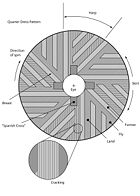
Thirlage
Thirlage was the term used for the law in regard of the milling of grain for personal or other uses. Vassals in a feudal barony were thirled to their local mill owned by the feudal superior...
was the feudal law by which the laird {lord) could force all those farmers living on his lands to bring their grain to his mill to be ground. Additionally they had to carry out repairs on the mill, maintain the lade and weir as well as conveying new millstones to the site. The width of some of the first roads was determined by the requirements of at least two people on either side of a grindstone with a wooden axle called a 'mill-wand'.
The Thirlage Law was repealed in 1779 and after this many mills fell out of use as competition and unsubsidised running costs took their toll. This may explain why so many mills went out of use, as deduced from comparing Armstrong's 1775 map with the 1885 OS map
Ordnance Survey
Ordnance Survey , an executive agency and non-ministerial government department of the Government of the United Kingdom, is the national mapping agency for Great Britain, producing maps of Great Britain , and one of the world's largest producers of maps.The name reflects its creation together with...
.
For example, Lambroch Mill on the River Annick served Lambroughton
Lambroughton
Lambroughton is a village in the old Barony of Kilmaurs, North Ayrshire, Scotland. This is a rural area famous for its milk and cheese production and the Ayrshire or Dunlop breed of cattle.-Origins of the name:...
and apart from the weir and some other indications, it has entirely vanished.
The Museum of Country Life
The three-storey grain store has been converted during the main restoration period of 1985 to 1987, to house an extensive collection of Ayrshire farming and domestic memorabilia, reflecting the self sufficiency of the pre-industrial rural community that was Dalgarven. Displays include the themes of ploughing, threshingThreshing
Threshing is the process of loosening the edible part of cereal grain from the scaly, inedible chaff that surrounds it. It is the step in grain preparation after harvesting and before winnowing, which separates the loosened chaff from the grain...
, harvesting and the village smithy
Forge
A forge is a hearth used for forging. The term "forge" can also refer to the workplace of a smith or a blacksmith, although the term smithy is then more commonly used.The basic smithy contains a forge, also known as a hearth, for heating metals...
. An antique shop is housed in an old outbuilding, a cafe provides snacks and meals and the original mill on the River Garnock
River Garnock
The River Garnock, the smallest of Ayrshire's six principal rivers, has its source on the southerly side of the Hill of Stake in the heart of the Clyde Muirshiel Regional Park. About a mile and a half south of this starting point the untested stream tumbles over the Spout of Garnock, the highest...
's edge is being developed.
The River Garnock
For centuries the waters of the Garnock have supplied the motive power for the work of the mill. A weir and mill lade or race direct the waters to the mill's waterwheel.The interior of the mill
The interiors of the mill buildings have been entirely restored from the derelict condition that they had fallen into.Exhibition areas
An upper floor of the mill is divided up into separate areas that recreate Victorian scenes from middle and working class houses.Costume collection
The mill houses an extensive collection of costume and clothing from every walk of life. The exhibition area on the ground floor of the building is used to display items from the extensive collection.The exhibitions are changed regularly. The costume collection is put to other practical purposes, such as for educational visits, open days and other special purposes.
Country life in days gone by
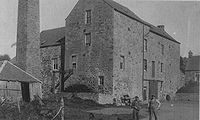
Quoits
Quoits is a traditional game which involves the throwing of metal, rope or rubber rings over a set distance, usually to land over or near a spike . The sport of quoits encompasses several distinct variations.-The history of quoits:The history of quoits is disputed...
, early vacuum cleaner
Vacuum cleaner
A vacuum cleaner, commonly referred to as a "vacuum," is a device that uses an air pump to create a partial vacuum to suck up dust and dirt, usually from floors, and optionally from other surfaces as well. The dirt is collected by either a dustbag or a cyclone for later disposal...
s, washing machines, blacksmith
Blacksmith
A blacksmith is a person who creates objects from wrought iron or steel by forging the metal; that is, by using tools to hammer, bend, and cut...
s' tools, etc. The single room in a cottars house has been re-created, complete with box-beds, girnal, swee and other features, such as the bible-chair.
On each floor the restored mill machinery is open to view (hoppers, grindstones, wheel gearing, etc.) and on the ground floor is an exhibition of the stages in the restoration of the mill. The exhibition shows the enormous amount of work that had to be done to bring the mill back to life.
In the grounds of the mill are a number of items of interest, such as a cast-iron milestone
Milestone
A milestone is one of a series of numbered markers placed along a road or boundary at intervals of one mile or occasionally, parts of a mile. They are typically located at the side of the road or in a median. They are alternatively known as mile markers, mileposts or mile posts...
and various horse- and tractor-drawn ploughs, whin crushing stone, etc.
Education
School groups can visit the mill as part of their studies and are given guided tours and / or specific talks on the many topics which are covered by the trust's collections. The riverside walk provides many opportunities for various studies, such as river life, wildflower meadows, biodiversity, geography, geology, etc. The water wheel gives a focus for studying sustainability.Cup and ring mark stone
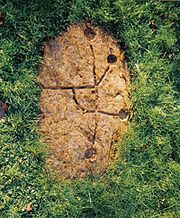
Petroglyph
Petroglyphs are pictogram and logogram images created by removing part of a rock surface by incising, picking, carving, and abrading. Outside North America, scholars often use terms such as "carving", "engraving", or other descriptions of the technique to refer to such images...
called a cup and ring mark
Cup and ring mark
Cup and ring marks or cup marks are a form of prehistoric art found mainly in Atlantic Europe and Mediterranean Europe although similar forms are also found throughout the world including Mexico, Brazil, Greece, and India, where...
stone is recorded as existing at Dalgarven by John Smith, the notable Ayrshire antiquarian. Unfortunately the exact whereabouts of the stone is unknown; however a copy has been produced and is on display in the grounds of the mill. The purpose of cup and ring marked stones is unknown. The carvings on the original stone would have dated from the Neolithic
Neolithic
The Neolithic Age, Era, or Period, or New Stone Age, was a period in the development of human technology, beginning about 9500 BC in some parts of the Middle East, and later in other parts of the world. It is traditionally considered as the last part of the Stone Age...
or Bronze age
Bronze Age
The Bronze Age is a period characterized by the use of copper and its alloy bronze as the chief hard materials in the manufacture of some implements and weapons. Chronologically, it stands between the Stone Age and Iron Age...
times, being as old as 6000 years. This Dalgarven example is unusual in having cups and connecting toughs, but no rings. Often up to five concentric rings are found circling the central cup.
Fossils
FossilFossil
Fossils are the preserved remains or traces of animals , plants, and other organisms from the remote past...
-bearing limestone
Limestone
Limestone is a sedimentary rock composed largely of the minerals calcite and aragonite, which are different crystal forms of calcium carbonate . Many limestones are composed from skeletal fragments of marine organisms such as coral or foraminifera....
boulders are sometimes found in the river with fossilized tree fern roots and imprints of the trunk. These represent long-extinct plant species which grew to an impressive height compared to their modern relatives which only reach a few feet. Millions of years ago these plants thrived in a warm and hospitable climate and gave rise to much of the Scottish coal
Coal
Coal is a combustible black or brownish-black sedimentary rock usually occurring in rock strata in layers or veins called coal beds or coal seams. The harder forms, such as anthracite coal, can be regarded as metamorphic rock because of later exposure to elevated temperature and pressure...
deposits.
Riverside walk

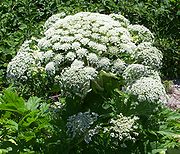
River Garnock
The River Garnock, the smallest of Ayrshire's six principal rivers, has its source on the southerly side of the Hill of Stake in the heart of the Clyde Muirshiel Regional Park. About a mile and a half south of this starting point the untested stream tumbles over the Spout of Garnock, the highest...
. In spring, the wild flower meadow is at its best, in summer, sit by the riverbank and watch the heron, swallows, kingfisher
Kingfisher
Kingfishers are a group of small to medium sized brightly coloured birds in the order Coraciiformes. They have a cosmopolitan distribution, with most species being found in the Old World and Australia...
and other wildlife. A Community Woodland has been established and the site is open access.
The gravel bed of the river was an important source of income for the millers, for through the estate they had sole right to the extraction of the gravel here, which was sold for various farm and horticultural purposes.
The meadows are particularly rich in pignut (Conopodium majus
Conopodium majus
Conopodium majus is a small perennial herb, whose underground part resembles a chestnut and is sometimes eaten as a wild or cultivated root vegetable....
), a relative of parsley, which formed a breaktime snack for children in former times. If the plant is dug up a small potato-like structure is found which when eaten raw has a slightly nutty taste. It is available commercially for salads, etc.
Hemlock water dropwort
Water dropwort
The water dropworts, Oenanthe , are a genus of plants in the family Apiaceae. Most of the species grow in damp ground, in marshes or in water....
grows well in the wetter areas and is best left alone as the name hemlock suggests. The large leaves of the butterbur
Butterbur
The plants commonly referred to as Butterbur are found in the daisy family Asteraceae in the genus Petasites. They are mostly quite robust plants with thick, creeping underground rhizomes and large Rhubarb-like leaves during the growing season...
(Petasites hybridus) are found in several areas; its name harkens back to the days before clingfilm or cheap paper when the leaves were used to wrap butter destined for the market. Water ragwort (or Saracen's ragwort) (a species of Senecio) is an introduced plant which grows along the riverside in tall stands. It is common on the Garnock and at present quite rare elsewhere. Himalayan balsam
Himalayan Balsam
Impatiens glandulifera is a large annual plant native to the Himalayas. Via human introduction it is now extant across much of the Northern Hemisphere.-Etymology:...
or policemen's helmets is another introduction, but a common one. Giant hogweed is beginning to make its presence felt. It is another plant which should never be handled as the sap can cause severe blistering and scarring of the skin. Ayrshire Rivers Trust are a local conservation charity that have been highly effective controlling invasive weeds in Ayrshire and are soon to tackle Giant Hogweed on the Garnock and other rivers in North Ayrshire. More information on the work of the Trust is available through their website at www.ayrshireriverstrust.org
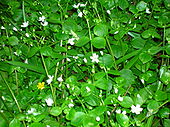
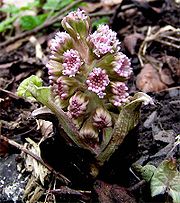
Claytonia sibirica
Claytonia sibirica is a flowering plant in the family Portulacaceae, native to Siberia and western North America. A synonym is Montia sibirica...
) is common in wetter areas. It has white or pink flowers at this site, but closer to Stewarton
Stewarton
Stewarton is a town in East Ayrshire, Scotland. In comparison to the neighbouring towns of Kilmaurs, Fenwick, Dunlop and Lugton, it is a relatively large town, with a population of over 6,500. It is 300 feet above sea level.Groome, Francis H. . Ordnance Gazetteer of Scotland. Pub. Caxton. London....
it is almost always white. It seems that it was first introduced as a white variety in the Stewarton area in Victorian times and the common pink variety, introduced later, spread to other areas. Dalgarven, it seems, is on the edge of the white flower zone of dominance. Dalgarven is the only known site for the Pocket Plum gall Taphrina padi
Taphrina padi
Taphrina padi is a fungal plant pathogen that induces the form of Pocket Plum gall that occurs on Bird Cherry . The gall is a chemically induced distortion of the fruits, which are swollen, hollow, curved and greatly elongated, without a seed or stone, but retaining the style...
which develops on Bird Cherry.
Coppicing
Coppicing
Coppicing is a traditional method of woodland management which takes advantage of the fact that many trees make new growth from the stump or roots if cut down. In a coppiced wood, young tree stems are repeatedly cut down to near ground level...
of the riverside alder
Alder
Alder is the common name of a genus of flowering plants belonging to the birch family . The genus comprises about 30 species of monoecious trees and shrubs, few reaching large size, distributed throughout the North Temperate Zone and in the Americas along the Andes southwards to...
trees is still carried out. Alders grow well in wet soils and are specially adapted for the low nutrient conditions through having large root nodules containing nitrogen-fixing bacteria which enrich the soil in the same way as clover plants and other legumes.
The many hedgerow trees in the vicinity of the mill were not planted by farmers for 'visual effect', they were crops and the wood was used for building and fencing. The miller needed beech
Beech
Beech is a genus of ten species of deciduous trees in the family Fagaceae, native to temperate Europe, Asia and North America.-Habit:...
or hornbeam
Hornbeam
Hornbeams are relatively small hardwood trees in the genus Carpinus . Though some botanists grouped them with the hazels and hop-hornbeams in a segregate family, Corylaceae, modern botanists place the hornbeams in the birch subfamily Coryloideae...
wood for mill machinery, in particular the cogs on the drive wheels from the waterwheel.
It is not generally appreciated how much the Ayrshire landscape has changed its character over the last few hundred years, for even in the 1760-70 Statistical Account it is stated that "there was no such thing to be seen as trees or hedges in the parish; all was naked and open".
Countryside walks and the Sustrans cyclepath

Sustrans
Sustrans is a British charity to promote sustainable transport. The charity is currently working on a number of practical projects to encourage people to walk, cycle and use public transport, to give people the choice of "travelling in ways that benefit their health and the environment"...
cyclepath from Irvine and Largs to Glasgow runs close nearby and cyclists often drop in for refreshment and a look around before heading up passed the Blair Estate and then along the old Lochwinnoch railway line via the Clyde Muirshiel Regional Park
Clyde Muirshiel Regional Park
Clyde Muirshiel Regional Park is the collective name for areas of countryside set aside for conservation and recreation on the South Clyde estuary in Scotland....
to Johnstone
Johnstone
Johnstone is a town in the council area of Renfrewshire and larger historic county of the same name in the west central Lowlands of Scotland.The town lies three miles west of neighbouring Paisley and twelve miles west of the centre of the city of Glasgow...
, Glasgow
Glasgow
Glasgow is the largest city in Scotland and third most populous in the United Kingdom. The city is situated on the River Clyde in the country's west central lowlands...
or Kilmacolm. The Dusk Water joins the Garnock at Dalgarven and one of Ayrshire's most interesting natural curiosities, Cleeves Cove cave
Cleeves Cove cave
Cleeves Cove is a cave system on the Dusk Water in North Ayrshire, Scotland, close to the town of Dalry.-The cave system:Cleeves, or Cleaves, cove cave system is situated in the lower bed of carboniferous limestone. It measures around 500 feet if all the passages were put together...
system in the Dusk Glen, is within walking distance via Cockenzie and Auchenskeith farms.
Geocaching
The popular pastime of geocachingGeocaching
Geocaching is an outdoor sporting activity in which the participants use a Global Positioning System receiver or mobile device and other navigational techniques to hide and seek containers, called "geocaches" or "caches", anywhere in the world....
is represented on the nature walk by a hidden cache which contains a log book for visitors' comments and a 'take something and leave something choice'. A GPS
Global Positioning System
The Global Positioning System is a space-based global navigation satellite system that provides location and time information in all weather, anywhere on or near the Earth, where there is an unobstructed line of sight to four or more GPS satellites...
is required for full participation, by logging on to the Geocaching website to enjoy visiting interesting (usually rural) locations.
Dalgarven Village
In 1881 some two hundred people lived in the village of DalgarvenDalgarven
The tiny village of Dalgarven in North Ayrshire, Scotland is located just north of Kilwinning on the road to Dalry.In 1881 some two hundred people lived in the village, the mill being at its heart, with a Sunday school, smithy, joiner's shop and Dalgarven House. Most of the women were weavers,...
, the mill at its heart, with a Sunday school, smithy, joiner's shop and Dalgarven House. Most of the women were weavers, dressmakers, farm or domestic servants. The men were stonemasons, joiners, farm labourers, platelayers, railway surfacemen, etc. Monkcastle House was at one end of the village and Smithstone House at the other. The coming of the new road resulted in the demolition of the village apart from the smithy, therefore ruining the ambience of the locality and very nearly eliminated the actual existence of Dalgarven village for ever.
No tolls were charged on Ayrshire Toll Roads for the transport of any kind of corn or grain to or from a mill.
Blair House
The home of the Borthwick family, Blair HouseBlair House
Blair House is the official state guest house for the President of the United States. It is located at 1651-1653 Pennsylvania Avenue NW in Washington, D.C., opposite the Old Executive Office Building of the White House, off the corner of Lafayette Park....
, is nearby and has a long tradition of allowing public access to its grounds. It is said to be the house with the longest continuous occupation by the same family in Scotland.
See also
- Coldstream MillHessilheadHessilhead is in Beith, North Ayrshire, Scotland. Hessilhead used to be called Hazlehead or Hasslehead. The lands were part of the Lordship of Giffen, and the Barony of Hessilhead, within the Baillerie of Cunninghame and the Parish of Beith...
- Cup and ring markCup and ring markCup and ring marks or cup marks are a form of prehistoric art found mainly in Atlantic Europe and Mediterranean Europe although similar forms are also found throughout the world including Mexico, Brazil, Greece, and India, where...
- Museum of Scottish Country Life
- Staddle stonesStaddle stonesStaddle stones were originally used as supporting bases for granaries, hayricks, game larders, etc. The staddle stones lifted the granaries above the ground thereby protecting the stored grain from vermin and water seepage...
- CunninghamheadCunninghamheadCunninghamhead is a hamlet in North Ayrshire, Scotland. It was the centre of the lands of Cunninghamhead, Perceton and Annick Lodge in Cunninghame...
Details of a series of mills on the Annick Water - A Researcher's Guide to Local History terminology

